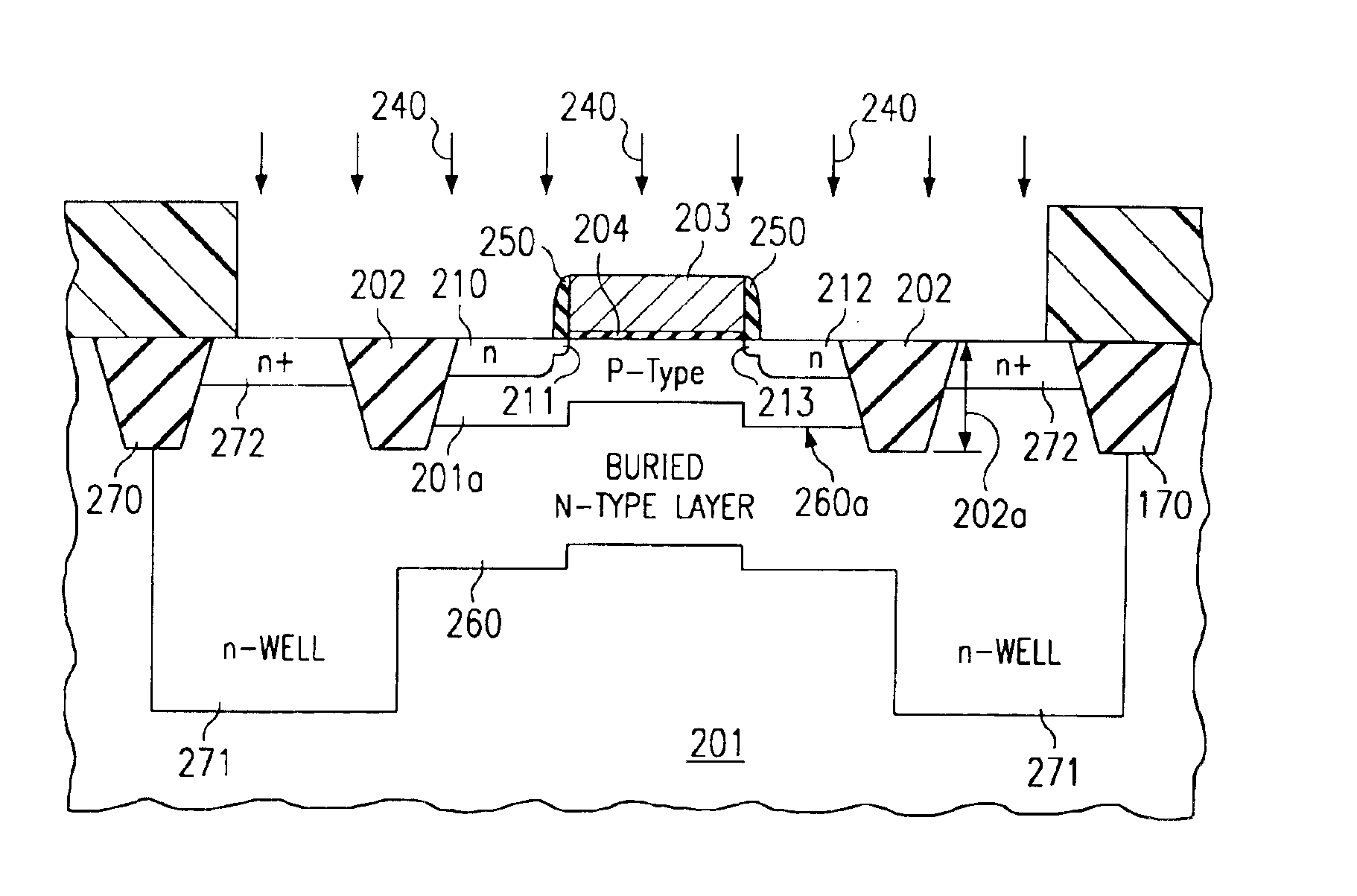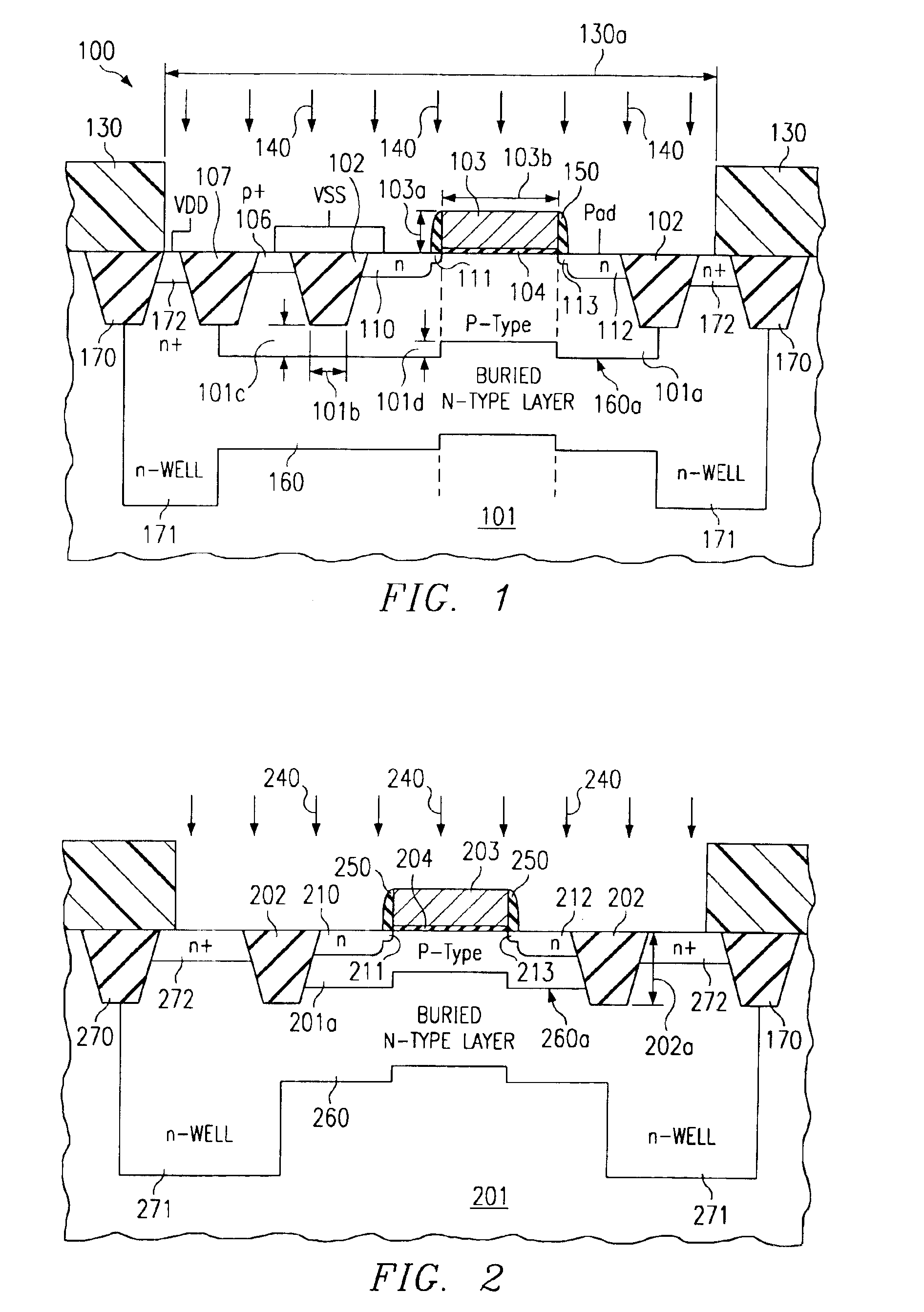Eliminating substrate noise by an electrically isolated high-voltage I/O transistor
a high-voltage i/o transistor and substrate noise technology, applied in the direction of semiconductor devices, electrical apparatus, basic electric elements, etc., can solve the problems of increasing the effect of noise coupling, affecting the performance of analog circuits, and economic unattractive, and achieves the effect of higher resistivity
- Summary
- Abstract
- Description
- Claims
- Application Information
AI Technical Summary
Benefits of technology
Problems solved by technology
Method used
Image
Examples
first embodiment
Vertically, the position of the buried layer 160 relative to the surface depends on the energy of the implanted ions. In the invention, which is depicted in FIG. 1, the buried layer edge 160a nearest the surface is deeper, i.e. farther away, from the surface than the bottom of the electrical isolation regions 102. This fact results in an electrically isolated p-type region 101a continuous under one portion of isolation region 102; this connecting portion is marked 101b in FIG. 1. The thickness 101c of the connecting portion is a function of the energy of the implanted n-type ions.
This continuity feature, in turn, enables a separate p+-contact 106 to the electrically isolated near-surface portion 101a of the p-type semiconductor region. The geometrical extent of the contact region 106 is limited by an additional isolation region 107, which simultaneously serves as one of the limiting “markers” for n-well 171.
It may be mentioned that the thickness of the photoresist layer 130 is large...
second embodiment
In the invention, the electrical contact to the isolated region 201a is provided by the design of source 210 as a “body-tied source”. The structure of this body-tied-to-source is schematically illustrated in the top view of the transistor in FIG. 3. Equal numbers refer to equal entities in FIGS. 2 and 3. The n+ contact 272 to the n-well (and thus the buried n-type layer) completely surrounds the nMOS transistor; n+ contact 272 is electrically connected to Vdd. Nested within the n+ contact is the shallow trench isolation 202. Gate 203 of the nMOS transistor may be designed in a variety of different shapes convenient for layout and electrical connections. N+-type drain contact region 212 is electrically connected to the I / O pad as the high voltage contact. The (n+-type) source contact regions 210 alternate laterally with the (p+-type) body contact regions 306 (not shown in FIG. 2). Overlaid metal contact layer 310 joins the electrical contacts to source and body and provides the elect...
third embodiment
In the invention, the electrical contact to the isolated region 201a (the body) is provided by a design practiced in the silicon-on-insulator technology: The gate is structured in an “H”-shape or a “T”-shape. An example is illustrated in the schematic top view of FIG. 4 for an H-shaped gate of an nMOS transistor. Equal numbers refer to equal entities in FIGS. 2 and 4. The n+ contact 272 to the n-well (and thus the buried n-type layer) completely surrounds the nMOS transistor; n+ contact 272 is electrically connected to Vdd. Nested within the n+ contact is the shallow trench isolation 202. Gate 203 of the nMOS transistor may be designed in a variety of different shapes such as H-shape (as Shown in FIG. 4) or T-shape. N+-type drain contact region 212 is electrically connected to the I / O pad as the high voltage contact. N+-type source contact region 210 is connected to Vss. P+-type body contacts 406 are also connected to Vss.
By way of example for an nMOS transistor as shown in FIG. 2, ...
PUM
 Login to View More
Login to View More Abstract
Description
Claims
Application Information
 Login to View More
Login to View More - R&D
- Intellectual Property
- Life Sciences
- Materials
- Tech Scout
- Unparalleled Data Quality
- Higher Quality Content
- 60% Fewer Hallucinations
Browse by: Latest US Patents, China's latest patents, Technical Efficacy Thesaurus, Application Domain, Technology Topic, Popular Technical Reports.
© 2025 PatSnap. All rights reserved.Legal|Privacy policy|Modern Slavery Act Transparency Statement|Sitemap|About US| Contact US: help@patsnap.com



